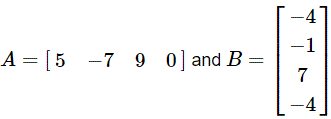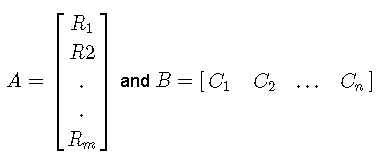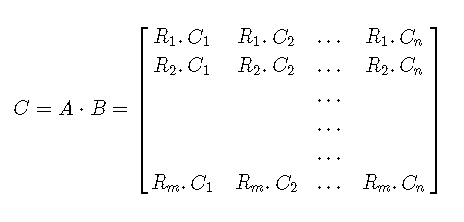Multiplication and Power of Matrices
The multiplications of matrices
are presented using examples and questions with solutions.
Multiplication of Rows and Columns Matrices
Let A be a row matrix of order 1 × p with entries a1j and B be a column matrix of order p × 1 with entries bj1. The multiplication of matrix A by matrix B is a 1 × 1 matrix defined by:

Example 1
Matrices A and B are defined by

Find the matrix A B.
Solution

Multiplication of Matrices
We now apply the idea of multiplying a row by a column to multiplying more general matrices. Let A be an m × p matrix and B be an p × n matrix.
Let R1, R2, ... Rm be the rows of matrix A and C1, C2, ... Cn be the columns of column B and write the two matrices as:

The product of the two matrices A and B is matrix C of order m × n defined by

Example 2
\( \) \( \) \( \) \( \)
Find the product
\( \begin{bmatrix}
2 & -1 & 0 \\
1 & 2 & 2
\end{bmatrix} \cdot \begin{bmatrix}
2 & - 2 \\
1 & 0 \\
-1 & 2
\end{bmatrix} \)
Solution
The matrix on the left has 2 rows R1 and R2 the matrix on the right has 2 columns C1 and C2. Their product is given by:
\( \begin{bmatrix}
2 & -1 & 0 \\
1 & 2 & 2
\end{bmatrix} \cdot \begin{bmatrix}
2 & - 2 \\
1 & 0 \\
-1 & 2
\end{bmatrix}
= \begin{bmatrix}
R_1 \\
R_2
\end{bmatrix} \cdot \begin{bmatrix}
C_1 & C_2 \\
\end{bmatrix}
=
\begin{bmatrix}
R_1\cdot C_1 & R_1 \cdot C_2 \\
R_2\cdot C_1 & R_2 \cdot C_2
\end{bmatrix}
\)
\(
= \begin{bmatrix}
\begin{bmatrix}
2 & -1 & 0
\end{bmatrix} \cdot \begin{bmatrix}
2 \\
1 \\
-1
\end{bmatrix} & \begin{bmatrix}
2 & -1 & 0
\end{bmatrix} \cdot \begin{bmatrix}
-2 \\
0 \\
2
\end{bmatrix} \\\\
\begin{bmatrix}
1 & 2 & 2
\end{bmatrix} \cdot \begin{bmatrix}
2 \\
1 \\
-1
\end{bmatrix} & \begin{bmatrix}
1 & 2 & 2
\end{bmatrix} \cdot \begin{bmatrix}
-2 \\
0 \\
2
\end{bmatrix}
\end{bmatrix}
=
\begin{bmatrix}
(2)(2)+(-1)(1)+(0)(-1) & (2)(-2) + (-2)(0) +(0)(2) \\
(1)(2)+(2)(1)+(2)(-1) & (1)(-2) + (2)(0) +(2)(2)
\end{bmatrix}
=
\begin{bmatrix}
3 & -4 \\
2 & 2
\end{bmatrix}
\)
Power of a Matrix
The power of a square matrix A is defined as follows:
\( A^0 = I \), \(I \) the identity matrix
\( A^n = A A .... A \) (n times) , where n is a positive integer.
If m and n are positive integers, then
\( A^m A^n = A^{m+n} \)
\( (A^m)^n = A^{m n} \)
Properties of Matrix Multiplication
- The product \( A B \) of two matrices \( A \) and \( B \) is defined if the number of columns of matrix \( A \) is equal to the number of rows of matrix \( B \).
- In general, the product of two matrices is not commutative: \( A B \ne B A \)
- Matrix multiplication is associative: \( (A B) C = A ( B C) \) if all the multiplications are defined.
- Matrix multiplication is distributive: \( A ( B + C ) = A B + A C \) and \( ( A + B ) C = A C + B C \)
- Multiplication by an identity matrix \( I \): \( A I = I A = A\) , this holds for square matrices of dimension n by n.
- For α and β real: \( \alpha ( A + B ) = \alpha A + \alpha B \)
- For α and β real: \( \alpha ( \beta A ) = \alpha \beta ( A ) \)
- For α and β real: \( (\alpha + \beta) A = \alpha A + \beta A \)
- For α real: \( \alpha ( A B ) = (\alpha A) B = A (\alpha B) \)
Questions on Multiplication of Matrices
- Part 1
A, B, C, D and E are matrices with the orders
A: 2 × 3 , B: 3 × 5 , C: 5 × 1 , E: 1 × 5
Which of the following are defined?
- \( A B \)
- \( A C \)
- \( C E \)
- \( E C \)
- \( (A B)C \)
- Part 2
A, B, C, D and E are matrices given by:
\[
A = \begin{bmatrix}
-1 & 1 & -2 \\
0 & -2 & 1
\end{bmatrix}
,\quad
B = \begin{bmatrix}
-1 & 2 & 0 \\
0 & -3 & 4 \\
-1 & -2 & 3
\end{bmatrix}
,\quad
C = \begin{bmatrix}
-3 & 2 & 9 & -5 & 7
\end{bmatrix} \\
D = \begin{bmatrix}
-2 & 6 \\
-5 & 2
\end{bmatrix}
,\quad
E = \begin{bmatrix}
3 \\
5 \\
-11
\end{bmatrix}
,\quad
F = \begin{bmatrix}
-1 & 0 & 2 \\
-2 & -3 & 4 \\
1 & 4 & -3
\end{bmatrix} \]
Find if possible:
- \( A B \)
- \( B C \)
- \( A D \)
- \( E F \)
- \( F E \)
- Part 3
Find x and y if
\[
\begin{bmatrix}
x + y & -2 \\
x - y & 1
\end{bmatrix} \begin{bmatrix}
2 & -1 \\
0 & -2
\end{bmatrix} = \begin{bmatrix}
8 & 0 \\
12 & -8 \\
\end{bmatrix}
\]
- Part 4
Calculate
\[ \left( \begin{bmatrix}
2&0&0\\
0&0&2\\
0&2&0
\end{bmatrix} \right)^{10}\]
Solutions to the Above Questions
- Part 1
A, B, C, D and E are matrices with the orders
A: 2 × 3 , B: 3 × 5 , C: 5 × 1 , E: 1 × 5
Which of the following are defined?
- \( A B \) : defined because the number of columns of A is equal to the number of rows of B.
- \( A C \) : NOT defined, the number of columns of A is NOT equal to the number of rows of C.
- \( C E \) : defined because the number of columns of C is equal to the number of rows of E.
- \( E C \) : defined because the number of columns of E is equal to the number of rows of C.
- \( (A B)C \) : defined because AB is defined (see above) and the results is a matrix of order 2 by 5. The number of columns of AB is equal to 5 which is equal to the number of rows of C.
- Part 2
- \( A B \) is defined and is given by
\(
A B = \begin{bmatrix}
-1 & 1 & -2 \\
0 & -2 & 1
\end{bmatrix}
\begin{bmatrix}
-1 & 2 & 0 \\
0 & -3 & 4 \\
-1 & -2 & 3
\end{bmatrix} = \begin{bmatrix} 3&-1&-2\\ -1&4&-5 \end{bmatrix}\)
- \( B C \) is not defined because the number of columns of B is not equal to the number of rows of C.
- \( A D \) is not defined because the number of columns of A is not equal to the number of rows of D.
- \( E F \) is not defined because the number of columns of E is not equal to the number of rows of F.
- \( F E \) is defined and is given by
\(
F E =
\begin{bmatrix}
-1 & 0 & 2 \\
-2 & -3 & 4 \\
1 & 4 & -3
\end{bmatrix}
\begin{bmatrix}
3 \\
5 \\
-11
\end{bmatrix}
= \begin{bmatrix}-25\\ -65\\ 56 \end{bmatrix}\)
- Part 3
Find the product
\(
\begin{bmatrix}
x + y & -2 \\
x - y & 1
\end{bmatrix}
\begin{bmatrix}
2 & -1 \\
0 & -2
\end{bmatrix} =
\begin{bmatrix}
2x + 2y & -x-y+4 \\
2x - 2y & -x+y-2
\end{bmatrix}
\)
then solve
\(
\begin{bmatrix}
2x + 2y & -x-y+4 \\
2x - 2y & -x+y-2
\end{bmatrix}
=
\begin{bmatrix}
8 & 0 \\
12 & -8
\end{bmatrix}
\)
Two matrices are equal if they have the same order and their corresponding entries are equal, hence the system of equations
\( 2x + 2y = 8 , -x-y+4 = 0 , 2x - 2y = 12 , -x+y-2 = - 8 \)
Solve to obtain
x = 5 and y = -1
- Part 4
Calculate
Rewrite the matrix as follows:
\[ \begin{bmatrix}
2&0&0\\
0&0&2\\
0&2&0
\end{bmatrix} = 2 \begin{bmatrix}
1&0&0\\
0&0&1\\
0&1&0
\end{bmatrix} \]
Hence
\[ \left( \begin{bmatrix}
2&0&0\\
0&0&2\\
0&2&0
\end{bmatrix} \right)^{10} = 2^{10} \left(\begin{bmatrix}
1&0&0\\
0&0&1\\
0&1&0
\end{bmatrix} \right)^{10} \]
We note that the matrix \( \begin{bmatrix}
1&0&0\\
0&0&1\\
0&1&0
\end{bmatrix} \) is an Row Operations and elementary matrix
corresponding to interchanging rows 2 and 3. So to raise the elementary matrix to the power 10, we start with the elementary and interchange rows 2 and 3 9 times which gives the original matrix
\[
\begin{bmatrix} 1&0&0\\ 0&1&0\\ 0&0&1 \end{bmatrix} \]
Hence
\[ \left(\begin{bmatrix}
1&0&0\\
0&0&1\\
0&1&0
\end{bmatrix} \right)^{10} = 2^{10}\begin{bmatrix}
1&0&0\\
0&1&0\\
0&0&1
\end{bmatrix} = \begin{bmatrix}
1024&0&0\\
0&1024&0\\
0&0&1024
\end{bmatrix} \]
More References and links


